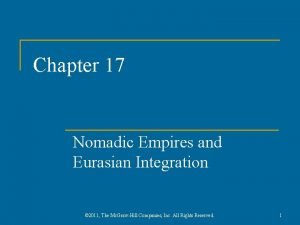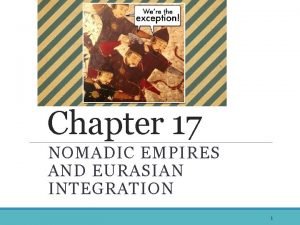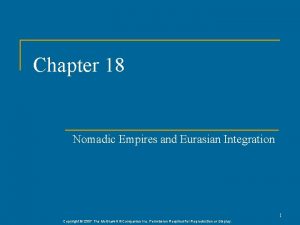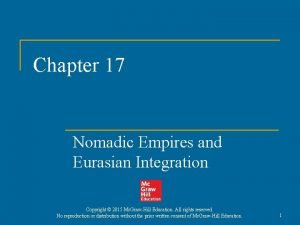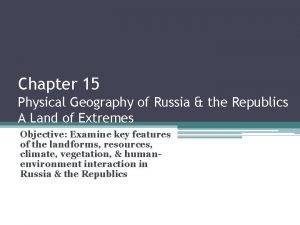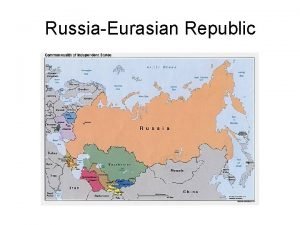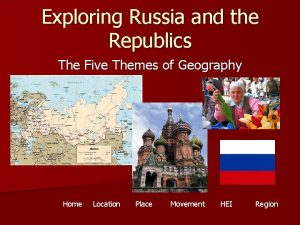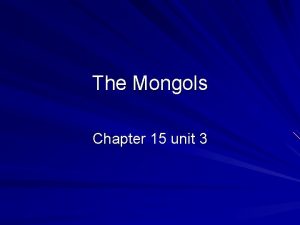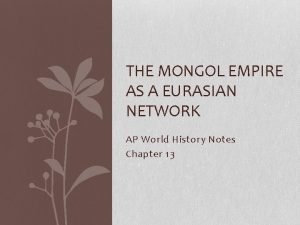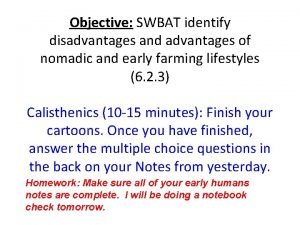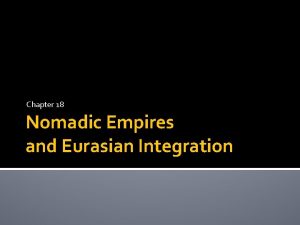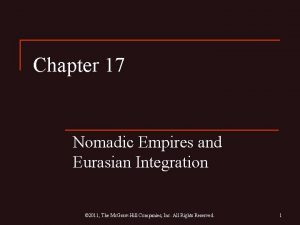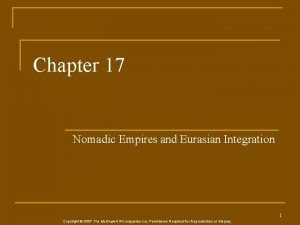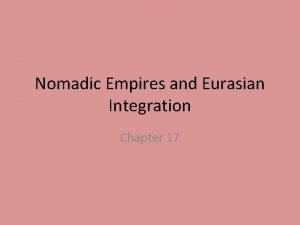Nomadic Empires and Eurasian Integration Chapter 18 pp










- Slides: 10


Nomadic Empires and Eurasian Integration Chapter 18 pp. 461 -480

The Eurasian Steppe • A belt of grassland from East Asia to Eastern Europe • Agriculture difficult • Herding leads to nomadic lifestyle • Low population • Great horseman, hunters, archers, warriors • Mongols, Turks, Indo-Iranians, Xiongnu (many others). Berbers (Africa). Bedouins (Arabia) • Always needed/ coveted goods from cities (trade or raid)

Mongol World War • Temujin • The Great Khan – Chinggis Khan • Begins conquests outside of Mongolia 1206 CE • Largest land empire • 40 -million deaths? • Baghdad devastated • Conquer China (Yuan Dynasty under Kublai Khan) • Christian Europe • Kievan Rus destroyed • Mongol failures • India, Southeast Asia, Japan • Mamluks defeat Mongols @ Battle of Ain Jalut 1260 CE

Technology and Innovation • Composite recurve bow • Military organization – the Tumen 10, 000 • Military tactics – feints, mounted archers, terror • Mongol mobility • Recruitment of foreigners – artisans, craftsmen, engineers • Postal system

Social Organization • Two social classes: Nobles and commoners • Heredity titles passed on but social mobility was possible • Clan and tribal system • Women = made clothes, milked the animals, made cheese, cooked food, raised the gers (yurts) • Men = handled the herds and went to battle • A place for skilled foreigners

Economic • Pastoral societies economies are based on herding • Trade with agrarian societies • Pax Mongolia – encouraged trade (Revival of Silk roads) • Increase in trade volume • Direct link of China and western Europe for the 1 st time

Cultural Interactions • Spread of religion • Migration: talented individuals • Diplomatic missions: Embassies • Bubonic plague • Yuan Dynasty = Mongols settle down in China; elites convert to Buddhism • Mongols convert to Islam in the Ilkhanate (Persia)

Political • Mongol rule was decentralized • Monarchy – Khanates • Social mobility • Relied on local political system to rule • In China they found Yuan Dynasty hire foreigners to govern. Mongols hold power. Chinese excluded. • In the Middle East rely on local bureaucracy • Tributary states

Mongol Decline • Assimilation • Population: 100, 000 -160, 000 • Bubonic plague • Factual divides • Poor governance • Economic (Persia) • Cultural (China) • Tamerlane
 Chapter 17 nomadic empires and eurasian integration
Chapter 17 nomadic empires and eurasian integration Nomadic empires and eurasian integration
Nomadic empires and eurasian integration Chapter 18 nomadic empires and eurasian integration
Chapter 18 nomadic empires and eurasian integration Chapter 17 nomadic empires and eurasian integration
Chapter 17 nomadic empires and eurasian integration Maritime and land based empires
Maritime and land based empires Russia and the eurasian republics physical map
Russia and the eurasian republics physical map What are the 15 countries of the soviet union
What are the 15 countries of the soviet union Russia 5 themes of geography
Russia 5 themes of geography Chapter 15 the last great nomadic challenges
Chapter 15 the last great nomadic challenges The mongol empire as a eurasian network
The mongol empire as a eurasian network Advantages and disadvantages of nomad life
Advantages and disadvantages of nomad life
